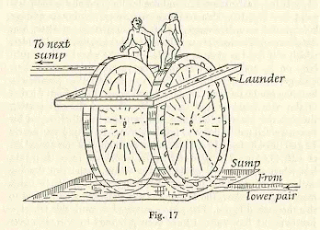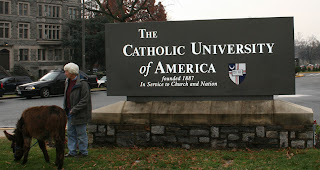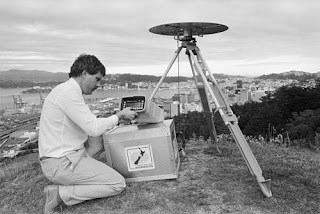Transportation engineering is the application of scientific p

rinciples to the safe and efficient movement of people and goods (transport). It is a sub-discipline of civil engineering.Transportation engineering is a major component of the civil engineering discipline. The importance of transportation engineering within the civil engineering profession can be judged by the number of divisions in ASCE (American Society of Civil Engineers) that are directly related to transportation. There are six such divisions (Aerospace; Air Transportation; Highway; Pipeline; Waterway, Port, Coastal and Ocean; and Urban Transportation) representing one-third of the total 18 technical divisions within the ASCE (1987).

The planning aspects of transport engineering relate to urban planning, and involve technical forecasting decisions and political factors. Technical forecasting of passenger travel usually involves an urban transportation planning model, requiring the estimation of trip generation (how many trips for what purpose), trip distribution (destination choice, where is the traveler going), mode choice (what mode is being taken), and route assignment (which streets or routes are being used). More sophisticated forecasting can  include other aspects of traveler decisions, including auto ownership, trip chaining (the decision to link individual trips together in a tour) and the choice of residential or business location (known as land use forecasting). Passenger trips are the focus of transport engineering because they often represent the peak of demand on any transportation system.
include other aspects of traveler decisions, including auto ownership, trip chaining (the decision to link individual trips together in a tour) and the choice of residential or business location (known as land use forecasting). Passenger trips are the focus of transport engineering because they often represent the peak of demand on any transportation system.
A review of descriptions of the scope of various committees indicates that while facility planning and design continue to be the core of the transportationengineeringfield, such operations planning, logistics,  network analysis, financing, and policy analysis are also important to civil engineers, particularly to those working in highway and urban transportation.
network analysis, financing, and policy analysis are also important to civil engineers, particularly to those working in highway and urban transportation.
Transportation engineering, as practiced by civil engineers, primarily involves planning, design, construction, maintenance, and operation of transportation facilities. The facilities support air, highway, railroad, pipeline, water, and even space transportation. The design aspects of transport engineering include the sizing of transportation facilities (how many lanes or how much capacity the facility has), determining the materials and thickness used in pavement designing the geometry (vertical and horizontal alignment) of the roadway (or track).
Operations and management involve traffic engineering, so that vehic les move smoothly on the road or track. Older techniques include signs, signals, markings, and tolling. Newer technologies involve intelligent transportation systems, including advanced traveler information systems (such as variable message signs), advanced traffic control systems (such as ramp meters), and vehicle infrastructure integration. Human factors are an aspect of transport engineering, particularly concerning driver-vehicle interface and user interface of road signs, signals, and markings.
les move smoothly on the road or track. Older techniques include signs, signals, markings, and tolling. Newer technologies involve intelligent transportation systems, including advanced traveler information systems (such as variable message signs), advanced traffic control systems (such as ramp meters), and vehicle infrastructure integration. Human factors are an aspect of transport engineering, particularly concerning driver-vehicle interface and user interface of road signs, signals, and markings.
THE TRANSPORTATION PROFESSION
Transportation professionals are responsible for planning, designing, and operating streets and highways, transit systems, airports, railroads, ports, and harbors to provide for the safe, rapid, comfortable, convenient, economical and environmentally compatible movement of people and goods.
As a transportation professional you can work on a wide variety of projects, such as:
- investigating and minimizing the effects of new developments and proposed highway projects on air and noise pollution, wetlands, and other aspects of the environment, as well as socio-economic impacts
- implementing ways to relieve traffic congestion, such as bus/carpool lanes on roadways and encouraging the use of public transportation
- planning, designing and operating parking facilities for airports, shopping centers, recreational, industrial, office and residential developments
- preparing traffic impact studies for new developments and determining transportation improvements to mitigate the additional traffic
- planning, designing, and operating airports, railroads, ports, and harbors
- planning and designing pedestrian circulation systems at universities, malls, and other busy pedestrian areas to ensure safety
- designing and controlling a computerized traffic signal system to allow for efficient movement of traffic
- inventing ways to increase the capacity and safety of roadways through the use of Intelligent Transportation Systems
TRANSPORTATION CAREERS
Transportation professionals work in planning, design and construction, operations, and research, among many other fields.
Planning
As a transportation planner you will work with other transportation professionals, as well as people in technical vocations, neighborhood groups and public officials. Many projects require the preparation of environmental documents since the project's success may depend on minimizing the effects on air, water, noise and wildlife. Noise barriers, landscaping or special design considerations may be required. It is the planners responsibility to meet each challenge and to present a solution that both does the job and addresses the concerns of the public. You may be called upon to justify your plan to neighborhood groups, lawyers, business leaders, news media and elected officials.
Design and Construction
As a transportation designer, you may be challenged to build a bridge that is compatible with the surrounding landscaping, or to design a ramp for a busy existing interchange. The design phase relies greatly on computer technology, as do most transportation fields. Computers aid in actually drawing transportation facilities. With the use of the computer, the engineer can experiment with many different alternatives to determine the most efficient design with the least adverse impact and lowest cost.
If you like to work outdoors, you might prefer the construction phase. From a spectacular bridge project to a simple lane widening, the construction engineer is responsible for the final product . . . that it is built as designed and that the correct materials are used. The construction field is constantly changing with new methods being introduced on practically every project.
Operations
Transportation operations is another important field of the transportation profession. Traffic engineers are responsible for design, implementation and maintenance of traffic controls, signs and pavement markings. Traffic control is essential for safe travel on ordinary roads and construction work zones, detours, and for special events. Traffic engineers use computers to monitor the flow of traffic onto existing freeways, to control parking decks, analyze accident locations, determine roadway capacities, improve traffic flow at intersections, and coordinate the operation of traffic signals throughout a city. Traffic engineers must work with developers, planners and designers to meet the challenge of providing a safe and efficient transportation system. The field of operations also includes working with public transportation. Public transportation professionals are challenged to determine the routes and service frequency to meet the demand at the least cost.
Research
In the field of research you'll tackle the unknown. Maybe you'll develop a new computer program for an on-board automobile navigational system or discover new ways to design automated "smart" highways. You'll work on the latest technology and with top thinkers in the profession. You might be part of a team assigned to a large federal project or manage your own smaller study for a private concern - working today on the transportation systems of tomorrow.
EDUCATION
A good background in science and mathematics, the ability to communicate effectively through speaking and writing and a basic understanding of government are all beneficial first steps in becoming a transportation professional.
Transportation professionals should prepare for their careers through college education. Many transportation professionals are enrolled in engineering programs, primarily civil, electrical, mechanical or chemical engineering. However, due to the diverse nature of the transportation profession, many transportation professionals have a background in planning, science, environmental planning, computers, and a number of other fields. Transportation courses may include transportation planning, traffic engineering, railroad engineering, highway design, airport design and related courses such as computer science, statistics, urban planning, geography, economics, business management and public administration.
Transportation engineering skills may also be obtained through employment and through numerous training conferences and short courses on various transportation engineering aspects offered by employers, universities and professional engineering societies.
Not all transportation careers require a four year college degree. There is a need for draftspersons, surveyors, computer programmers, sign makers and installers, traffic signal THE TRANSPORTATION PROFESSION
Transportation professionals are responsible for planning, designing, and operating streets and highways, transit systems, airports, railroads, ports, and harbors to provide for the safe, rapid, comfortable, convenient, economical and environmentally compatible movement of people and goods.
As a transportation professional you can work on a wide variety of projects, such as:
* investigating and minimizing the effects of new developments and proposed highway projects on air and noise pollution, wetlands, and other aspects of the environment, as well as socio-economic impacts
* implementing ways to relieve traffic congestion, such as bus/carpool lanes on roadways and encouraging the use of public transportation
* planning, designing and operating parking facilities for airports, shopping centers, recreational, industrial, office and residential developments
* preparing traffic impact studies for new developments and determining transportation improvements to mitigate the additional traffic
* planning, designing, and operating airports, railroads, ports, and harbors
* planning and designing pedestrian circulation systems at universities, malls, and other busy pedestrian areas to ensure safety
* designing and controlling a computerized traffic signal system to allow for efficient movement of traffic
* inventing ways to increase the capacity and safety of roadways through the use of Intelligent Transportation Systems
TRANSPORTATION CAREERS
Transportation professionals work in planning, design and construction, operations, and research, among many other fields.
Planning
As a transportation planner you will work with other transportation professionals, as well as people in technical vocations, neighborhood groups and public officials. Many projects require the preparation of environmental documents since the project's success may depend on minimizing the effects on air, water, noise and wildlife. Noise barriers, landscaping or special design considerations may be required. It is the planners responsibility to meet each challenge and to present a solution that both does the job and addresses the concerns of the public. You may be called upon to justify your plan to neighborhood groups, lawyers, business leaders, news media and elected officials.
Design and Construction
As a transportation designer, you may be challenged to build a bridge that is compatible with the surrounding landscaping, or to design a ramp for a busy existing interchange. The design phase relies greatly on computer technology, as do most transportation fields. Computers aid in actually drawing transportation facilities. With the use of the computer, the engineer can experiment with many different alternatives to determine the most efficient design with the least adverse impact and lowest cost.
If you like to work outdoors, you might prefer the construction phase. From a spectacular bridge project to a simple lane widening, the construction engineer is responsible for the final product . . . that it is built as designed and that the correct materials are used. The construction field is constantly changing with new methods being introduced on practically every project.
Operations
Transportation operations is another important field of the transportation profession. Traffic engineers are responsible for design, implementation and maintenance of traffic controls, signs and pavement markings. Traffic control is essential for safe travel on ordinary roads and construction work zones, detours, and for special events. Traffic engineers use computers to monitor the flow of traffic onto existing freeways, to control parking decks, analyze accident locations, determine roadway capacities, improve traffic flow at intersections, and coordinate the operation of traffic signals throughout a city. Traffic engineers must work with developers, planners and designers to meet the challenge of providing a safe and efficient transportation system. The field of operations also includes working with public transportation. Public transportation professionals are challenged to determine the routes and service frequency to meet the demand at the least cost.
Research
In the field of research you'll tackle the unknown. Maybe you'll develop a new computer program for an on-board automobile navigational system or discover new ways to design automated "smart" highways. You'll work on the latest technology and with top thinkers in the profession. You might be part of a team assigned to a large federal project or manage your own smaller study for a private concern - working today on the transportation systems of tomorrow.
EDUCATION
A good background in science and mathematics, the ability to communicate effectively through speaking and writing and a basic understanding of government are all beneficial first steps in becoming a transportation professional.
Transportation professionals should prepare for their careers through college education. Many transportation professionals are enrolled in engineering programs, primarily civil, electrical, mechanical or chemical engineering. However, due to the diverse nature of the transportation profession, many transportation professionals have a background in planning, science, environmental planning, computers, and a number of other fields. Transportation courses may include transportation planning, traffic engineering, railroad engineering, highway design, airport design and related courses such as computer science, statistics, urban planning, geography, economics, business management and public administration.
Transportation engineering skills may also be obtained through employment and through numerous training conferences and short courses on various transportation engineering aspects offered by employers, universities and professional engineering societies.
Not all transportation careers require a four year college degree. There is a need for draftspersons, surveyors, computer programmers, sign makers and installers, traffic signal technicians and construction inspectors.
PROSPECTIVE EMPLOYERS
Most transportation engineers are employed by local, state or federal agencies, or by private consulting firms. Many are engaged in teaching and research at colleges and universities. Job opportunities are often publicized through engineering-oriented publications such as ITE Journal, a magazine published monthly by the Institute of Transportation Engineers. In addition, most universities have job-placement programs to help their graduating students find employment. technicians and construction inspectors.
PROSPECTIVE EMPLOYERS
Most transportation engineers are employed by local, state or federal agencies, or by private consulting firms. Many are engaged in teaching and research at colleges and universities. Job opportunities are often publicized through engineering-oriented publications such as ITE Journal, a magazine published monthly by the Institute of Transportation Engineers. In addition, most universities have job-placement programs to help their graduating students find employment.
 ter,Factories etc that has a foundation,wall,roof etc that protect human being and their properties from direct harsh effect of weather like rain,wind,sun etc.
ter,Factories etc that has a foundation,wall,roof etc that protect human being and their properties from direct harsh effect of weather like rain,wind,sun etc. is home construction"; "workers in the building t rades"
is home construction"; "workers in the building t rades"


 TRANSIT THEODOLITE
TRANSIT THEODOLITE nd the vertical circle rotate in vertical plane.
nd the vertical circle rotate in vertical plane.
 rinciples to the safe and efficient movement of people and goods (transport). It is a sub-discipline of civil engineering.Transportation engineering is a major component of the civil engineering discipline. The importance of transportation engineering within the civil engineering profession can be judged by the number of divisions in ASCE (American Society of Civil Engineers) that are directly related to transportation. There are six such divisions (Aerospace; Air Transportation; Highway; Pipeline; Waterway, Port, Coastal and Ocean; and Urban Transportation) representing one-third of the total 18 technical divisions within the ASCE (1987).
rinciples to the safe and efficient movement of people and goods (transport). It is a sub-discipline of civil engineering.Transportation engineering is a major component of the civil engineering discipline. The importance of transportation engineering within the civil engineering profession can be judged by the number of divisions in ASCE (American Society of Civil Engineers) that are directly related to transportation. There are six such divisions (Aerospace; Air Transportation; Highway; Pipeline; Waterway, Port, Coastal and Ocean; and Urban Transportation) representing one-third of the total 18 technical divisions within the ASCE (1987).
 include other aspects of traveler decisions, including auto ownership, trip chaining (the decision to link individual trips together in a tour) and the choice of residential or business location (known as land use forecasting). Passenger trips are the focus of transport engineering because they often represent the peak of demand on any transportation system.
include other aspects of traveler decisions, including auto ownership, trip chaining (the decision to link individual trips together in a tour) and the choice of residential or business location (known as land use forecasting). Passenger trips are the focus of transport engineering because they often represent the peak of demand on any transportation system. network analysis, financing, and policy analysis are also important to civil engineers, particularly to those working in highway and urban transportation.
network analysis, financing, and policy analysis are also important to civil engineers, particularly to those working in highway and urban transportation. les move smoothly on the road or track. Older techniques include signs, signals, markings, and tolling. Newer technologies involve
les move smoothly on the road or track. Older techniques include signs, signals, markings, and tolling. Newer technologies involve 




 physical, chemical, and biological processes into systems to destroy toxic substances, remove pollutants from water, reduce non-hazardous solid waste volumes, eliminate contaminates from the air, and develop groundwater supplies. In this field, you may be called upon to resolve issues of providing safe drinking water, cleaning up sites contaminated with hazardous materials, disposing of wastewater, and managing solid wastes.
physical, chemical, and biological processes into systems to destroy toxic substances, remove pollutants from water, reduce non-hazardous solid waste volumes, eliminate contaminates from the air, and develop groundwater supplies. In this field, you may be called upon to resolve issues of providing safe drinking water, cleaning up sites contaminated with hazardous materials, disposing of wastewater, and managing solid wastes. ause most projects
ause most projects
 of its transportation system,
of its transportation system,
 elopment of a community. Analyzing a variety of information will help you coordinate projects, su ch as projecting street patters, identifying park and recreation areas, and determining areas f o r industrial and residential growth. To ensure ready access to your community, coordination with other authorities may be required to integrate freeways, airports, and other related facilities. Successful coordination of a project will require you to be people-oriented as well as technically knowledgeable.
elopment of a community. Analyzing a variety of information will help you coordinate projects, su ch as projecting street patters, identifying park and recreation areas, and determining areas f o r industrial and residential growth. To ensure ready access to your community, coordination with other authorities may be required to integrate freeways, airports, and other related facilities. Successful coordination of a project will require you to be people-oriented as well as technically knowledgeable.








 ng of property boundaries. It involves the re-establishment of cadastral surveys and land boundaries based on documents of record and historical evidence, as well as certifying surveys (as required by statute or local ordinance) of subdivision plats/maps, registered land surveys, judicial surveys, and space delineation. Land surveying can include associated services such as mapping and related data accumulation, construction layout surveys, precision measurements of length, angle, elevation, area, and volume, as well as horizontal and vertical control surveys, and the analysis and utilization of land survey data.
ng of property boundaries. It involves the re-establishment of cadastral surveys and land boundaries based on documents of record and historical evidence, as well as certifying surveys (as required by statute or local ordinance) of subdivision plats/maps, registered land surveys, judicial surveys, and space delineation. Land surveying can include associated services such as mapping and related data accumulation, construction layout surveys, precision measurements of length, angle, elevation, area, and volume, as well as horizontal and vertical control surveys, and the analysis and utilization of land survey data. be the inventor of the first practical mobile phone for hand-held use in a non-vehicle setting, after a long race against Bell Labs for the first portable mobile phone. Using a modern, if somewhat heavy portable handset, Cooper made the first call on a hand-held mobile phone on April 3, 1973 to his rival, Dr. Joel S. Engel of Bell Labs.
be the inventor of the first practical mobile phone for hand-held use in a non-vehicle setting, after a long race against Bell Labs for the first portable mobile phone. Using a modern, if somewhat heavy portable handset, Cooper made the first call on a hand-held mobile phone on April 3, 1973 to his rival, Dr. Joel S. Engel of Bell Labs.














